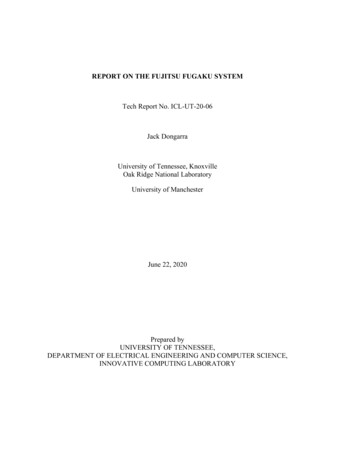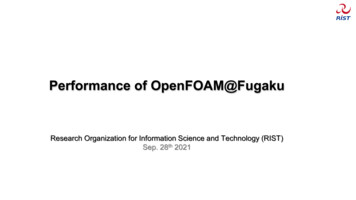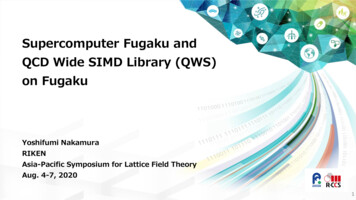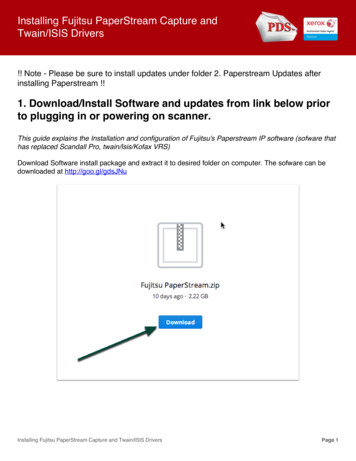
Transcription
REPORT ON THE FUJITSU FUGAKU SYSTEMTech Report No. ICL-UT-20-06Jack DongarraUniversity of Tennessee, KnoxvilleOak Ridge National LaboratoryUniversity of ManchesterJune 22, 2020Prepared byUNIVERSITY OF TENNESSEE,DEPARTMENT OF ELECTRICAL ENGINEERING AND COMPUTER SCIENCE,INNOVATIVE COMPUTING LABORATORY
OverviewThe Fugaku compute system was designed and built by Fujitsu and RIKEN. Fugaku 富岳, isanother name for Mount Fuji, created by combining the first character of 富士, Fuji, and 岳,mountain. The system is installed at the RIKEN Center for Computational Science (R-CCS) inKobe, Japan. RIKEN is a large scientific research institute in Japan with about 3,000 scientists inseven campuses across Japan. Development for Fugaku hardware started in 2014 as thesuccessor to the K computer. The K Computer mainly focused on basic science and simulationsand modernized the Japanese supercomputer to be massively parallel. The Fugaku system isdesigned to have a continuum of applications ranging from basic science to Society 5.0, aninitiative to create a new social scheme and economic model by fully incorporating thetechnological innovations of the fourth industrial revolution. The relation to the Mount Fujiimage is to have a broad base of applications and capacity for simulation, data science, and AI—with academic, industry, and cloud startups—along with a high peak performance on large-scaleapplications.Figure 1. Fugaku System as installed in RIKEN R-CCSThe Fugaku system is built on the A64FX ARM v8.2-A, which uses Scalable Vector Extension(SVE) instructions and a 512-bit implementation. The Fugaku system adds the following Fujitsuextensions: hardware barrier, sector cache, prefetch, and the 48/52 core CPU. It is optimized forhigh-performance computing (HPC) with an extremely high bandwidth 3D stacked memory, 4x8 GB HBM with 1024 GB/s, on-die Tofu-D network BW ( 400 Gbps), high SVE FLOP/s (3.072TFLOP/s), and various AI support (FP16, INT8, etc.). The A64FX processor provides forgeneral purpose Linux, Windows, and other cloud systems. Simply put, Fugaku is the largest andfastest supercomputer built to date. Below is further breakdown of the hardware. Caches:o L1D/core: 64 KB, 4way, 256 GB/s (load), 128 GB/s (store)o L2/CMG: 8 MB, 16 wayo L2/node: 4 TB/s (load), 2 TB/s (store)o L2/core: 128 GB/s (load), 64 GB/s (store)158,976 nodesJune 22, 20201
o 384 nodes 396 racks 152,064o 192 nodes 36 racks 6,9124.85 PB of total memory163 PB/s memory bandwidthTofu-D 6D Torus network, 6.49 PB/s injection bandwidth (o (28 Gbps 2 lanes 10 ports)15.9 PB of NVMe L1 storagePCIe Gen3 16Many-endpoint 100 Gbps I/O network into LustreThe first “exascale” machine (not for 64-bit floating point but in applicationperformance).Work on the Fugaku system began as the “Post K” computer. The origins date back to 2006 withplanning for a follow on to the K Computer system in Kobe.The deployment of the Fugaku system was done in a pipelined fashion. The first rack wasshipped on December 3, 2019, and all racks were on the floor by May 13, 2020. Early users hadaccess to the system in the first quarter of 2020.Figure 2. Fugaku Deployment TimetableWorking with Fujitsu to co-design a processor began in 2011 with a goal of a 100 speedup overexisting applications on the K Computer.The CPU is based on ARM architecture version 8.2A and adopts the SVE instructions. Fujitsu isthe manufacturer, and the CPU chip is based on a TSMC 7 nm FinFET & CoWoS technologiesJune 22, 20202
using Broadcom SerDes, HBM I/O, and SRAMS. The total number of transistors is 87.86 billionwith 594 signal pins.The A64FX processor is a many-core ARM CPU with 48 compute cores and 2 or 4 assistantcores used by the operating system. It uses a new core design with the ARM V8, 64-bit ARMecosystem, Tofu-D interconnect and PCIe Gen3 16 external connections. While the processordoes not have a GPU accelerator, it has the SVE 512-bit 2 vector extensions that can operate atintegers 1, 2, 4, and 8 bytes and floating point 16, 32, and 64 bit levels. The on-package memoryis HBM2 with massive memory bandwidth with a bytes-per-DP floating point ratio of 0.4 bytesper FLOP and is capable of streaming memory, strided, and gather-scatter accesses.Figure 3. A64FX Processor LayoutJune 22, 20203
RIKEN Kobe CampusThe Kobe Campus opened in April 2002 as a central research center of the Kobe BiomedicalInnovation Cluster promoted by the city of Kobe. The Campus is recognized as an internationalresearch center for performing research on developmental biology for multicell organisms,developing a platform for health promotion, and conducting research in areas such ascomputational science and computer science. As a research center, more than 1,200 scientistsand assistants are working to resolve various issues affecting society through collaborating withmedical institutions, research institutes, and corporations. The R-CCS is the leading researchcenter in HPC and computational science in Japan, operated the K computer from 2012–2019,and now is running the Fugaku computer. Their objectives are to investigate “the science of(high performance) computing, by computing, and for computing,” to promote the corecompetence of the research in a concrete fashion as open-source software, and to collaboratewith many other leadership centers around the globe.Fugaku System ConfigurationThe Fugaku machine includes a total of 158,976 nodes, with 384 nodes per rack 396 (full)racks 152,064 nodes and 192 nodes/rack 36 (half) racks 6,912 nodes. By comparison, theK Computer had 88,128 nodes.Figure 4. System ConfigurationJune 22, 20204
Unit# of nodesDescriptionCPU1Single-socket node with HBM2 and Tofu interconnect DCMU2CPU Memory Unit: 2 CPUBoB16Bunch of Blades: 8 CMUShelf483 BoBRack3848 ShelfSystem152,064As a Fugaku systemFigure 5. System CharacteristicsIn terms of theoretical peak performance, the following characteristics are given: Normal Mode (CPU Frequency of 2 GHz)o 64-bit, double-precision FP: 488 PFLOP/so 32-bit, single-precision FP: 977 PFLOP/so 16-bit, half-precision FP (AI training): 1.95 EFLOP/so 8-bit integer (AI Inference): 3.90 ExaopsBoost Mode (CPU Frequency of 2.2 GHz)o 64-bit, double-precision FP: 537 PFLOP/so 32-bit, single-precision FP: 1.07 EFLOP/so 16-bit, half-precision FP (IEEE Float, AI training): 2.15 EFLOP/so 8-bit integer (AI Inference): 4.30 ExaopsTheoretical Peak Memory Bandwidth: 163 Petabytes/sThe basic node level performance shows: Stream triad: 830 GB/sDGEMM: 2.5 TFLOP/sWhen compared to the K Computer, we see the following improvements: 64-bit, double-precision FP: 48 speedup32-bit, single-precision: 95 speedup16-bit, half-precision (AI training): 190 speedupK Computer theoretical peak: 11.28 PFLOP/s (all precisions)8-bit integer (AI Inference): 1,500 speedupK Computer theoretical peak: 2.82 PFLOP/s (64-bit FP)June 22, 20205
Theoretical peak memory bandwidth: 29 speedupK Computer theoretical peak: 5.64 PB/sStorage SystemThe storage system consists of three primary layers: 1st Layero Cache for global file systemo Temporary file systems§ Local file system for compute node§ Shared file system for a job2nd Layero Lustre-based global file system3rd Layero Cloud storage services (in preparation)Power Efficiency and CoolingThe peak power consumption under load (running the HPL benchmark) is 28.33 MW or 14.7GFLOP/s per watt. This includes all components, such as PSU, FANs in the rack. The coolingsolution uses a closed-coupled chilled configuration with a custom water-cooling unit. The CPUMemory Unit (CMU) is also water cooled.June 22, 20206
Figure 6. Node boardTofu Interconnect NetworkTofu stands for “torus fusion” and represents the designed combination of dimensions with anindependent configuration and a routing algorithm. The letter D represents high “density” nodeand “dynamic” packet slicing for “dual-rail” transfer. The 6-D mesh/torus network of Tofuachieves high scalability for the compute nodes, and the virtual 3-D torus rank mapping schemeprovides both high availability and topology-aware programmability.A node address in the physical 6-D network is represented by six-dimensional coordinates X, Y,Z, A, B, and C. The A and C coordinates can be 0 or 1, and the B coordinate can be 0, 1, or 2.The range of the X, Y, and Z coordinates depends on the system size.Two nodes the coordinates of which are different by 1 in one axis and identical in the other fiveaxes are “adjacent” and are connected to each other. When a certain axis is configured as a torus,the node with coordinate 0 in the axis, and the node with the maximum coordinate value areconnected to each other. The A- and C-axes are fixed to the mesh configuration, and the B-axisis fixed to the torus configuration. Each node has 10 ports for the 6-D mesh/torus network. Eachof the X-, Y-, Z-, and B-axes uses two ports, and each of the A- and C-axes uses one port. Eachlink provides 5.0 GB/s peak throughput. Each link has 8 lanes of high-speed differential I/Osignals at a 6.25-Gbps data rate.Tofu was implemented as an interconnect controller (ICC) chip with 80 lanes of signals for thenetwork. The table below shows the comparison of node and link configurations within the Tofufamily. TofuD uses a high-speed signal of 28-Gbps data rate that is approximately 9% faster thanthat of Tofu2. However, owing to the reduction of the number of signals, TofuD reduces the linkbandwidth to 6.8 GB/s, which is approximately 54% for Tofu2. To compensate for the reductionin the link bandwidth, TofuD increases the number of simultaneous communications from 4 ofTofu2 to 6. The injection rate of TofuD is enhanced to approximately 80% of that of Tofu2.There are six adjacent nodes in the virtual 3-D torus, and therefore topology-aware algorithmsJune 22, 20207
can use six simultaneous communications effectively. Tofu and Tofu2 were the previousinterconnect networks used on the K computer and the Fujitsu PRIMEHPC FX100 system.Figure 7. Tofu D InterconnectPeak PerformanceFugaku NormalMode (2.0 GHz)Fugaku Boost Mode(2.2 GHz)K ComputerPeak DoublePrecision (64 bit)488 PFLOP/s537 PFLOP/s11.3 PFLOP/sPeak SinglePrecision (32 bit)977 PFLOP/s1.07 EFLOP/s11.3 PFLOP/sHalf Precision (16bit float, IEEEstandard)1.95 EFLOP/s2.15 EFLOP/s--Integer (8 bit)3.9 EFLOP/s4.3 EFLOP/s--Total Memory4.85 PB--Total MemoryBandwidth163 PB/s--5.18 TB/sFigure 8. Peak PerformanceHigh Performance LINPACK, HPCG, and HPL-AI BenchmarksThe Fugaku system achieved an HPL number of 415 PFLOP/s on 152,064 nodes (potential peakis 514 PFLOP/s). (This is 96% of the full system, the full system has 158,976 nodes.) As a result,they will be the new #1 system on the TOP500. The power efficiency is at 14.7 GFLOP/s perwatt. The system also achieved an HPCG number of 13 PFLOP/s, and so Fugaku will be #1 onthe HPCG list as well.June 22, 20208
Notably, Fugaku’s HPL number is 80.9% of the peak performance, and their HPCG is 2.8% ofpeak. For comparison, the US Department of Energy’s (DOE’s) Summit system at Oak RidgeNational Laboratory (ORNL) achieved an HPL score of 149 PFLOP/s, which is 74% of peakperformance at 14.7 GFLOP/s per watt, and the HPCG number stands at 2.93 PFLOP/s, which is1.3% of peak.The HPL-AI benchmark seeks to highlight the emerging convergence of high-performancecomputing (HPC) and artificial intelligence (AI) workloads. While traditional HPC focused onsimulation runs for modeling phenomena in physics, chemistry, biology, and so on, themathematical models that drive these computations require, for the most part, 64-bit accuracy.On the other hand, the machine learning methods that fuel advances in AI achieve desired resultsat 32-bit and even lower floating-point precision formats. The HPL-AI drops the requirement of64-bit computation throughout the entire solution process and instead opting for low-precision(likely 16-bit) accuracy for LU, and a sophisticated iteration to recover the accuracy lost infactorization. The iterative method guaranteed to be numerically stable is the generalizedminimal residual method (GMRES), which uses application of the L and U factors to serve as apreconditioner. The combination of these algorithms is demonstrably sufficient for high accuracyand may be implemented in a way that takes advantage of the current and upcoming devices foraccelerating AI workloads.For the HPL-AI benchmark Fugaku achieves a stunning 1.42 Exaflops/s and is number 1 in theperformance. For comparison the DOE ORNL Summit system achieves .55 Exaflop/s on thebenchmark and is number 2.The Software StackThe Spack package manager will be used to manage open-source software on Fugaku. Spack is apackage manager for HPC, Linux, and macOS intended to make installing scientific softwaremuch easier. Spack is not tied to a particular language; the user can build a software stack inPython or R, link to libraries written in C, C , or Fortran, and easily swap compilers or targetspecific microarchitectures.Fugaku users can easily use pre-installed packages and build packages based on Spack recipes.The following list shows the results of building/compiling packages for A64FX according to theSpack recipes. Note that the results in this list do not guarantee that each package will workproperly. On the other hand, Fujitsu will provide packages compiled with the Fujitsu compiler onFugaku as “external” packages, of which Spack can be made aware. OpenJDK11Ruby 2.6.5 or laterPython2 2.7.15Python3 3.6.8Numpy 1.14.3SciPy 1.0.0June 22, 20209
Eclipse IDE 2019-09 R PackagesA number of other software packages are also available: DL4FugakuChainerTensorFlowBLASLAPACKScaLAPACKSSL IIEigenEXAKMATH FFT3DBatched BLASFigure 9. Fugaku Software StackThe operating system is Red Hat Enterprise Linux 8 & McKernel (light-weight multi kerneloperating system).The MPI on the system is Fujitsu MPI (based on OpenMPI) and RIKEN-MPICH (based onMPICH).June 22, 202010
Commercial ApplicationsFujitsu works with vendors to make commercial apps, third party, independent software vendor(ISV) packages, available for FX1000, also for FX700 and Fugaku with binary compatibility:Application BenchmarksA number of applications benchmarks have been run and compared with the Fugaku A64FXprocessor.June 22, 202011
Figure 10. Fugaku Benchmark ResultsEarly Application and Ongoing ProjectsRIKEN, in coordination with the Japanese Ministry of Education, Culture, Sports, Science andTechnology (MEXT), has announced that the Fugaku supercomputer will be made available forresearch projects aimed to combat COVID-19. Below are some of the ongoing projects.Exploring New Drug Candidates for COVID-19 by “Fugaku”Yasushi Okuno, RIKEN / Kyoto UniversityCurrently, clinical trials are underway in Japan and overseas to confirm the effects of existingdrugs on COVID-19. Some reports have shown that a given drug could have efficacy throughthese clinical trials, but the number of cases has been small, and no effective therapeutic drug hasyet been identified. Furthermore, due to the small number of drugs being tested, it is possible thatnone of the drugs have a definite effect. Therefore, in this study, we perform molecular dynamicscalculations using “Fugaku” to search and identify therapeutic drug candidates showing highaffinity for the target proteins of COVID-19 from approximately 2,000 existing drugs that arenot limited to existing antiviral drugs targeted in clinical trials.Prediction of Conformational Dynamics of Proteins on the Surface of SARSCov-2 using FugakuYuji Sugita, RIKENOn the surface of the coronavirus, there are many spike proteins that interact with virial receptorACE2 on the host cell surface. To block the interaction between the spike protein and thereceptor is an important research subject to develop a drug for COVID-19. Recently, atomicstructures of the spike protein were determined using cryo-electron microscopy (cryo-EM). Weperform atomistic molecular dynamics (MD) simulations of the spike protein in solution toJune 22, 202012
predict experimentally undetectable dynamic structures. We use GENESIS MD software, whichallows us about 125 times faster MD simulations on Fugaku compared to the K computer.Furthermore, we enhance motions of a part of the spike protein using a multi-copy-simulationmethod to predict large-scale conformational dynamics of the spike proteins.Simulation Analysis of Pandemic PhenomenaNobuyasu Ito, RIKENSocial and economic impact is increasing globally, and Japan is now at critical bifurcation point.And challenges to make its visualization and “big data” mining have started. In this project,making the most of the “Fugaku” and other supercomputers, we make estimations of the possiblefuture of our social and economic activities and policy options to control and resolve thesituation. For this purpose, simulations of disease propagation and economic activities and SNStext mining are applied together with the National Institute of Advanced Industrial Science andTechnology, Kyoto University, Tokyo Institute of Technology, the University of Hyogo, theUniversity of Ryukyus, and the University of Tsukuba.Fragment Molecular Orbital Calculations for COVID-19 ProteinsYuji Mochizuki (Rikkyo University) conducts the project in close collaboration with ShigenoriTanaka (Kobe University) and Kaori Fukuzawa (Hoshi Univeristy). By using our ABINIT-MPprogram, a series of fragment molecular orbital (FMO) calculations are carried out on COVID19 proteins, and detailed interaction analyses are performed. Resulting data are made public aswell.ABINIT-MP has been used in the field of computational drug discovery for the last two decades,and a related consortium activity (FMODD) on the K computer was organized by Fukuzawa. Onthe present topic, we have performed FMO-based interaction analyses for a complex formedbetween a COVID-19 main protease and an inhibitor N3, where FX100 at Nagoya Universitywas employed for computations. The analyzed results were published as a paper at ChemRxivsite, a month after the release of the original PDB structure (6LU7). Crucial residues ininteracting with the inhibitor were identified by our analyses.Prediction and Countermeasure for Virus Droplet Infection under the IndoorEnvironmentMakoto Tsubokura, RIKEN / Kobe UniversityVirus droplet infection caused by sneezing, coughing, or talking is strongly influenced by theflow, temperature, and humidity of the air around an infected person and potential victims.Especially in the case of the new corona virus, possibility of aerosol infection by atomizeddroplets is suggested in addition to the usual droplet infection. Because smaller aerosol particlesdrift in the air for a longer time, it is imperative to predict the scattering route and to estimatehow surrounding airflow affects the infection so that the risk of droplet infection can be properlyassessed and effective measures to reduce infection can be proposed. In this project, massivelyparallel coupling simulation of virus droplet scattering, with airflow and heat transfer under theindoor environment such as inside a commuter train, offices, classrooms, and hospital rooms,June 22, 202013
will be conducted. By taking into account the characteristics of the virus, its infection risk ofvirus droplets is assessed under various conditions. Then countermeasures to reduce the risk areproposed from a viewpoint of controlling the airflow. This project is a collaboration withRIKEN, Kyoto Institute of Technology, Kobe University, Osaka University, ToyohashiUniversity of Technology, and Kajima Corporation.Fujitsu and HPE/CrayHPE/Cray announced the Cray CS500, which is based on the Fujitsu A64FX processor. Thisproduct provides a fully enabled Cray programming environment on the system. There have beena number of early adopters, including SUNY Stony Brook, DOE’s Los Alamos NationalLaboratory and ORNL, and University of Bristol. The SUNY Stony Brook system is a 5 milliontestbed project funded by the National Science Foundation and conducted in collaboration withRIKEN CCS in Japan.Fujitsu has also announced two A64FX systems called the PRIMEHPC FX1000 and FX700. Forcustomers inside Japan, FX1000 deployments start at a minimum of 48 nodes, and FX700 startsat a minimum of 2 nodes. For customers outside Japan, the entry point for FX1000 is 192 nodes,and the FX700 starts at 128 nodes.SummaryThe R-CCS Fugaku system is very impressive with over 7 million cores and a peak performanceof 514 PFLOP/s in 64-bit floating point for standard scientific computations and 2.15 EFLOP/sin 16-bit floating point (not bfloat16 floating point format) for machine-learning applications.The Fugaku system is almost three times (2.84 ) faster than the system it replaces in the numberone spot. The HPL benchmark result at 415 PFLOP/s, or 81% of theoretical peak performance, isalso impressive with an efficiency of 14.7 GFLOP/s per watt. The HPCG performance at only2.5% of peak performance shows the strength of the memory architecture performance. The ratioof bytes per floating-point operations from memory on the ARM A64FX HBM2 memory is 0.4bytes per double-precision FLOP/s, which shows a good balance for floating point operations todata transfer from memory. One would expect good performance on computational scienceproblems and machine-learning applications.June 22, 202014
Appendix A.Table A-1. Comparison with top machines on the TOP500Theoretical PeakRIKEN FugakuORNL SummitSunwayTaihuLightTianHe-2A514 PFLOP/s200 PFLOP/s (.54*2 CPU 6*7Accelerator)125.4 PFLOP/s CPEs MPEs94.97 PFLOP/s (7.52 CPU 87.45Accelerator)PFLOP/sCores per Node 256 CPEs 4 MPEsSupernode 256NodesSystem 160SupernodesCores 260 * 256 *160 10.6MHPL BenchmarkFLOP/s415 PFLOP/s149 PFLOP/s93 PFLOP/s13.987 PFLOP/s outof a theoretical peakof 21.86 PFLOP/s.HPL % peak81%74%74.16%63.98%HPCG benchmark13 PFLOP/s2.92 PFLOP/s.371 PFLOP/s4096 nodes.0798 PFLOP/sHPCG % peak2.8%1.5%0.30%0.365%Compute nodes152,064 (This is on96% of the fullsystem)4608 256 cabinets* 18 nodes/cabinet40,96017,792Node48 cores2 IBM POWER9CPUs 3.07 GHz plus6 Nvidia V100 (.54TFLOP/s each)Tesla GPUs / node(7 TFLOP/s each)256 CPEs 4 MPEs2 – Intel Ivy Bridge(12 cores, 2.2 GHz)plus 2 Matrix-2000,1.2 GHz)Node peakperformance3.4 TFLOP/s43 TFLOP/s 125.3376 TFLOP/s (2 211.2 CPU 2 2.4576Accelerator)TFLOP/s(1.08 CPU 42GPU) TFLOP/sJune 22, 2020A-1
Node memory32 GB HMB232 GB CPU 6 GBGPU32 GB per node64 GB CPU 128GB AcceleratorSystem memory4.85 PB1.76 PB 4608*600 GB ofcoherent memory(6 16 96 GBHBM2 plus2 8 32 512 GBDDR4 SDRAM)1.31 PB (32 GB 40,960 nodes)3.4 PB 17,792 (64 GB 128 GB)Configuration158,976 nodes256 Racks 18NodesNode peakperformance is 3.06TFLOP/s, or 11.7GFLOP/s per core.2 Nodes per blade,16 blades per frameand 4 frames percabinet and 139cabinets in thesystem.260 cores/nodeCPE: 8FLOPs/core/cycle(1.45 GHz 8 256 2.969 TFLOP/s)MPE (2 pipelines) 2 4 8 FLOPs/core/cycle(1.45 GHz 1 0.0928TFLOP/s)Node peakperformance: 3.06TFLOP/s1 thread/coreNodes connectedusing PCI-EThe topology isSunway network.256 nodes asupernode (256 3.06 TFLOP/s .783 PFLOP/s)160 supernodesmake up the wholesystem(125.4PFLOP/s)The network systemconsists of threedifferent levels, withJune 22, 2020A-2
the central switchingnetwork at the top,the super nodenetwork in themiddle, and theresource-sharingnetwork at thebottom.4 SNs cabinetEach cabinet 3.164PFLOP/s256 nodes per SN1,024 nodes (3TFLOP/s each) percabinet40 cabinets 125PFLOP/sTotal system7,630,848 158,976* 48 cores2,397,824 cores10,649,600 cores Node (260) supernodes(256nodes) 160supernodes4,981,760 cores (17,792 2 IvyBridge with 12cores) (2 Matrix-2000 128)Power (processors,memory,interconnect)28.33 MW11 MW15.3 MW16.9 MW for fullsystemFootprint1,920 m2520 m2605 m2400 m2 (50m2/line*8) or 720 m2total roomJune 22, 2020(7.33*3.863)A-3
June 22, 2020 1 Overview The Fugaku compute system was designed and built by Fujitsu and RIKEN. Fugaku 富岳, is another name for Mount Fuji, created by combining the first character of 富士, Fuji, and 岳, mountain.










